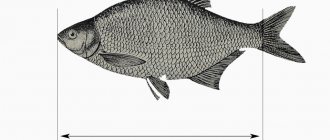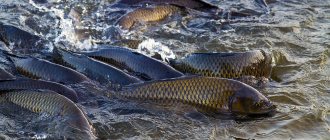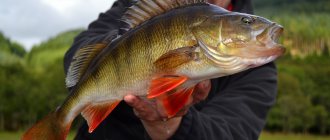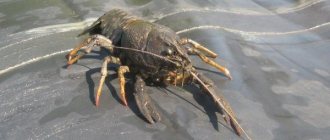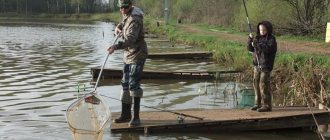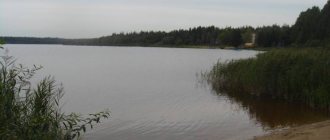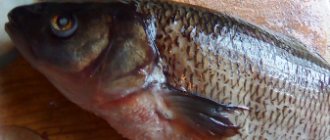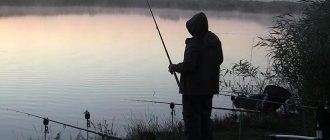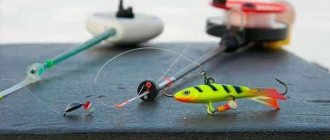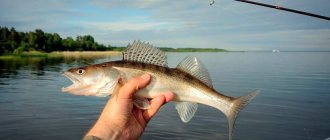This post was read by: 72,325
New fishing rules were introduced in January 2018 . Let everyone decide for themselves how to treat them, but I personally think that in some cases these changes will benefit both the fish population and some of us.
The new Fishing Rules, which came into force in January 2021, determine the types, parameters, terms and restrictions in fishing.
Amateur and sport fishing in 2021 is regulated by the so-called “fishing law,” namely Federal Law No. 166 (as amended on December 5, 2017) “On fishing and conservation of aquatic biological resources.”
As a result of many years of discussions about the “fishing law,” amendments to the new Fishery Rules were adopted and entered into force. A number of amendments concerning individual points of the Rules are still being updated.
The main thesis of the new Fishery Rules states that:
Recreational fishing is free and free
This means that the ban on fishing in areas of water bodies previously designated as “fishing areas” is being eliminated. There is a restriction on fishing in fish breeding areas of fisheries without approval.
Daily fish catch rates have been introduced for recreational fishermen, which vary somewhat for different fisheries basins. Live fish in a cage or livewell are also considered caught. This raises some questions and gives rise to discussions of new Fishery Rules.
- The daily fish catch rate per fisherman is 5 kg. The exception is the capture of a fish weighing more than five kilograms. This is recorded in the new edition of the Fishery Rules.
- The size of the catch per fisherman taken from the fishing site should not exceed twice the daily catch rate for 2 days. In this case, all fish are taken into account, including dried, salted, smoked, etc.
- The number of fish used as live bait for fishing with girders or other gear that uses such bait is limited. The number of live bait is up to 30 per fisherman per day.
As for catching crayfish, their number is limited to 30 per person per day. Catching small-sized fish, such as bleak, gudgeon, ruffe, is not limited in quantity.
The catch of pike perch, catfish, carp, fish, grass carp, silver carp, etc. is limited by the number of specimens. Moreover, the catch rate by the number of fish specimens may vary depending on the region.
Fines and sanctions for violations of the rules
Let's start with the fact that you can get a fine without even starting fishing. To do this, just leave the car near the water on the shore.
The car can be parked:
- on roads with hard surfaces (asphalt);
- on special sites with hard surfaces;
- outside water protection zones.
Depending on the type of reservoir, the boundary of the water protection zone ranges from 50 to 200 meters. For the sea - 500 meters.
The fine for violating the boundaries of the water protection zone ranges from 3.5 thousand to 5 thousand rubles.
What are the consequences of violating the Fishing Rules?
In accordance with Part 2 of Art. 8.37 of the Code of Administrative Offenses of the Russian Federation , violation of the Fishing Rules may entail the imposition of an administrative fine in the amount of 2,000 to 5,000 rubles with confiscation of gear and the vessel if it was used in the fishing process.
More serious fines are imposed for fishing during the spring spawning season. Fishing with prohibited gear during a “spawning ban”, or fishing in places designated as spawning grounds, the fine can amount to up to 300 thousand rubles.
Responsibility
In Art. 14 FZ-475 states that administrative and criminal liability is established for violation of the legislation on recreational fishing. The Fisheries Law in 2021 does not introduce fines for violators; they are specified in Art. 8.17, 8.37 Code of Administrative Offenses of the Russian Federation, Art. 256 of the Criminal Code of the Russian Federation. Administrative fines for individuals reach 5,000 rubles, criminal fines - 500,000 rubles.
An additional punishment to administrative liability may be confiscation of the vessel and fishing gear.
Alternative penalties to a criminal fine are:
- a fine in the amount of salary/other income for 2-3 years;
- compulsory work up to 480 hours;
- repair work up to 2 years;
- imprisonment for up to 2 years.
When illegal fishing is recognized as a crime, and it was committed by a group of persons in conspiracy and caused particularly large damage, then the fine can reach 1,000,000 rubles, and imprisonment - 5 years.
The Government has assessed the increase in the retirement age to 70 years - should we expect a new law?
Dates for the ban on fishing during spawning in 2018:
Astrakhan region from April 20 to June 20 from April 1 to June 30 - crayfish.
Bryansk region
from March 25 to April 25 - pike, ide; from April 5 to May 5 - asp; from October 1 to June 30 - crayfish; from March 25 to June 15 - with all fishing gear, with the exception of one float or bottom fishing rod from the shore with a total number of hooks of no more than 2 pieces
Vladimir region
from April 10 to May 20 - with all fishing gear, with the exception of one float or bottom fishing rod from the shore with a total number of hooks of no more than 2 pieces; from April 1 to May 1 - pike; from April 10 to May 10 - asp; from April 1 to May 10 - ide; from April 20 to May 20 - bream; from October 1 to June 30 - crayfish; from October 1 to April 30 - in wintering pits.
Voronezh region
from April 20 to July 31 - throughout the upper reaches of the Don River (including tributaries, branches, channels and hollow lakes); from November 15 to March 31 - in wintering pits located on water bodies of fishery importance in the Voronezh region; from January 1 to September 15 - freshwater crayfish everywhere; from April 20 to June 20 - you cannot go out on boats;
Ivanovo region
from April 15 to June 5 in the following areas from May 1 to June 5 - pike perch and bream; from April 15 to May 15 - pike.
Kaluga region
from April 1 to May 1 - pike; from April 10 to May 10 - asp; from May 1 to June 10 - with all fishing gear, with the exception of one float or bottom fishing rod from the shore with a total number of hooks of no more than 2 pieces from October 1 to April 1 - in wintering pits
Crimea republic
from April 1 to May 31 - in all water bodies of fishery importance, except from January 1 to May 31 - freshwater crayfish.
Leningrad region
from melting ice to June 15 - bream, pike perch and pike; from September 1 to freeze-up in lakes Otradnoe, Glubokoe, Vysokinskoye - whitefish and vendace; from March 1 to July 31 in rivers flowing into the Gulf of Finland, with the exception of the Narva River - from March 1 to June 30 in the Narva River - lamprey; from June 1 to December 31 with fixed nets (except for catching Atlantic salmon (salmon) for reproduction purposes in the Narva River); from May 20 to June 30 - pike perch and bream; from the melting of the ice to June 15 - production (catch) in the bays of the Vyborg Bay: Seleznevskaya, Podberezovaya, Malaya Pikhtovaya, as well as in Lake Zaychikhino; from the melting of ice until June 30 in Lake Tikhoye and in the channel connecting the lake with the Rosson River, in Lake Lipovskoye and in the channel connecting the lake with the Gulf of Finland.
Moscow and Moscow region
from April 1 to June 10 - with all fishing gear, with the exception of float rods from the shore with a total number of hooks of no more than 2 pieces per citizen outside spawning grounds from April 1 to May 10 - in the cooling ponds of the Shaturskaya and Elektrogorskaya State District Power Plants; from December 15 to January 15 - burbot; from October 1 to April 30 - in wintering pits from April 10 to June 10 - in spawning areas
Ryazan Oblast
from April 21 to May 31 - with all fishing gear, with the exception of fishing from the shore with one float or bottom fishing rod with a total number of hooks of no more than 2 pieces; from April 1 to May 10 - on the warm waters of the Ryazan State District Power Plant reservoir; from October 1 to April 30 - in wintering pits; from April 1 to May 1 - pike; from April 1 to May 10 - ide; from April 10 to May 10 - asp.
Smolensk region
from April 25 to June 5 - in the Desnogorsk reservoir; from March 22 to April 22 - pike in the Desnogorsk Reservoir; from April 1 to May 1 - pike in other water bodies of fishery importance; from April 10 to May 10 - asp; from April 1 to May 10 - ide; from May 5 to June 15 - with all fishing gear, with the exception of one float or bottom fishing rod from the shore with a total number of hooks of no more than 2 pieces; from October 1 to April 30 - in wintering pits; from October 1 to June 30 - crayfish.
Tver region
from May 1 to June 10 - in the Ivankovsky and Uglich reservoirs, in the Volga River from May 1 to September 10 - on the Vesso reach and in Ogorody Bay (from the village of Svetlitsa to from April 20 to May 30 - in lakes Pesvo and Udomlya; from May 5 to June 15 - in other water bodies of fishery importance in the region with all fishing gear, with the exception of one float rod from the shore with a general one from October 1 to April 30 - in wintering pits; from March 12 to April 20 - pike in cooling ponds Thermal power plants, state district power plants, nuclear power plants; from March 22 to April 30 - pike in other water bodies of fishery importance ; from April 1 to May 10 - ide; from April 10 to May 10 - asp; from April 1 to May 1 - pike perch.
Tula region
from April 10 to June 10 - with all fishing gear, with the exception of float rods from the shore with a total number of hooks of no more than 2 pieces from October 1 to April 30 - in wintering pits
Yaroslavl region
from April 25 to June 5 - in the Rybinsk Reservoir with all tributaries within the administrative boundaries of the Yaroslavl region outside spawning grounds from October 1 to April 30 - in wintering pits from April 20 to May 29 - in Lake Nero; from April 20 to May 9, from May 25 to June 13 and from November 15 to December 24 - in Lake Pleshcheyevo; from the melting of the ice to June 10 - in other water bodies of fishery importance in the region, with the exception of fishing with one float rod from the shore with a total number of hooks of no more than 2 pieces.
The rules establish a fine for each specimen of fish (crayfish) prohibited from catching during the spawning period. The fine is doubled if it is a female. For catching sturgeon species, an additional 100% is added, and for salmon – an additional 200% of the fine amount.
Illegal fishing
- using prohibited weapons (explosives, chemicals, electric fishing rods);
- in spawning areas or on migration routes to them;
- in specially protected natural areas
- causing major damage (the amount of damage is more than 100 thousand rubles).
may form a crime under Part 1 of Art. 256 of the Criminal Code of the Russian Federation and is punishable by a fine of up to 500 thousand rubles, or correctional labor for up to 2 years, or imprisonment for this period.
Spring spawning ban on fishing 2021 in Moscow and the Moscow region
An annual spawning ban begins in Russia. Each region has its own fishing rules. Familiarize yourself with them so as not to violate them during the spawning fishing ban in 2021. And remember that violation of the spawning ban in some cases may fall under criminal liability under Article 256 of the Criminal Code of the Russian Federation - you should not ruin your life by catching some kind of fish. It is also necessary to remember with what gear and where exactly you can fish during the spawning ban - this is indicated in the documents below.
30.25. Water bodies of fishery importance in the Moscow region and the city of Moscow:
30.25.1. Areas prohibited for extraction (catch) of aquatic biological resources:
a) on the Volga River at a distance of less than 1 km from the dam in the city of Dubna downstream (with the exception of the bay in the oxbow lake on the right side of the hydroelectric complex); b) in the Pestovsky Reservoir: from the mouth of the Kokotka River to a line passing through the bay from the pier of “Raketa” type vessels (along the right bank) to the military hunting base “Barskie Prudy” (along the left bank); the water area of the Berezovy Islands at a distance of less than 500 m from the water's edge; at a distance of less than 100 m from the water's edge and less than 500 m in both directions from the administrative boundaries of the village of Drachevo; c) on the Klyazma Reservoir: in Krasnaya Gorka Bay; d) in the Lutosnya River and its tributaries within the administrative boundaries of Solnechnogorsk and Dmitrovsky districts; e) in the Istra Reservoir: the water area of the Kostyaevsky Islands at a distance of less than 100 m from the water’s edge; the right bank water area of the Istra River from the mouth of the Chernaya River with a belt width of 50 m for 1.1 km towards Pyatnitsky Reach.
30.25.2. Prohibited periods (periods) of extraction (catch) of aquatic biological resources:
from March 22 to June 1 - in the cooling ponds of the Shaturskaya and Elektrogorskaya State District Power Plants; on other water bodies of fishery importance: from April 1 to June 10 - with all fishing gear, with the exception of one float or bottom fishing rod from the shore with a total number of hooks of no more than 2 pieces per citizen outside the spawning areas specified in Appendix No. 6 to the Fishery Rules “List of spawning sites located on water bodies of fishery importance in the Volga-Caspian fishery basin”; from October 1 to April 30 - in wintering pits specified in Appendix No. 5 to the Fishery Rules “List of wintering pits located on water bodies of fishery significance in the Volga-Caspian fishery basin”; from December 15 to January 15 – burbot.
30.25.3. Types of aquatic biological resources prohibited for production (catch):
sterlet, brown trout (freshwater resident form), freshwater catfish, grayling, podust, white-eye, bluefish, sabrefish, bersh, lampreys, crayfish.
30.25.4. Minimum size of extracted (caught) aquatic biological resources (commercial size):
When carrying out fishing, it is prohibited to produce (catch), accept, process, transship, transport, store and unload aquatic biological resources that have a fresh length (in cm) less than that specified in Table 27.
Table 27
Name of aquatic biological resources Fishing size, cm Asp 40 Pike-perch 40 Bream 25 Pike 32 Burbot 40 Carp 40 Chub 20 Ide 25
The commercial size of aquatic biological resources is determined in fresh form:
in fish - by measuring the length from the top of the snout (with the mouth closed) to the base of the middle rays of the caudal fin. Extracted (caught) aquatic biological resources having a length less than that specified in Table 27 are subject to immediate release into the natural habitat with the least damage.
Order of the Ministry of Agriculture of Russia dated November 18, 2014 N 453 (as amended on July 27, 2017) “On approval of fishing rules for the Volga-Caspian fishery basin”
Spring spawning fishing ban 2021 for the cities: Moscow, Balashikha, Podolsk, Khimki, Korolev, Mytishchi, Lyubertsy, Elektrostal, Krasnogorsk, Kolomna, Odintsovo, Serpukhov, Shchelkovo, Domodedovo, Orekhovo-Zuevo, Ramenskoye, Zhukovsky, Pushkino, Sergiev Posad , Dolgoprudny, Noginsk, Reutov, Voskresensk, Lobnya, Klin, Dubna, Ivanteevka, Yegoryevsk, Chekhov, Dmitrov, Stupino, Pavlovsky Posad, Vidnoye, Naro-Fominsk, Fryazino, Lytkarino, Dzerzhinsky, Solnechnogorsk, Kashira, Kotelniki, Krasnoznamensk, Protvino, Istra, Shatura, Mozhaisk, Lukhovitsy, Likino-Dulyovo, Dedovsk, Aprelevka, Krasnoarmeysk, Lakes, Losino-Petrovsky, Zaraysk, Elektrogorsk, Bronnitsy, Staraya Kupavna, Zvenigorod, Chernogolovka, Khotkovo, Pushchino, Kurovskoye, Volokolamsk, Elektrougli, Roshal, Kubinka , Golitsyno, Yakhroma, Peresvet, Ruza, Krasnozavodsk, Taldom, Drezna, Vysokovsk, Vereya
